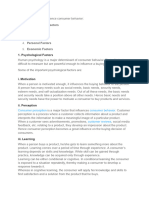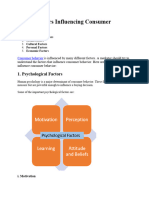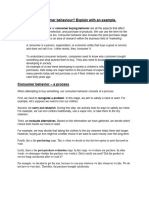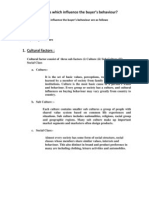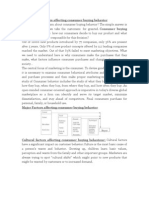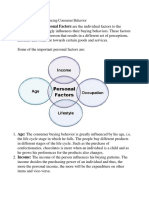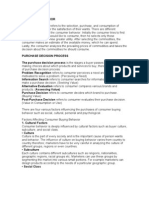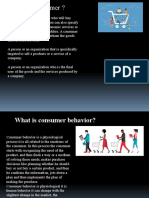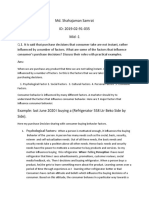Group 1
Psychological Factors
Interestingly, human psychology is actually an integral factor that influences consumer behavior although
these factors aren’t exactly easy to measure. A few integral psychological factors driving the behavior of
consumers are :
1. Motivation
Motivation actually becomes a considerable defining factor influencing a person’s buying behavior. A
popular motivation theory is Maslow's theory of hierarchy of needs in which he developed a model
that lays the foundation for 5 different levels of human needs where he lays the base with
psychological needs and moves on to safety needs, social needs, esteem needs and finally heading to
self-actualization needs. Amongst these requirements, our basic requirements and security needs
are generally put above all needs.
For instance, The U.S. Army’s famous “Be All You Can Be” slogan and advertising campaigns
encouraged young adults to join the army (self-actualization).
Perception
Our perception is shaped when we gather information regarding a product and examine it to
generate a relevant image regarding a certain product.
Whenever we see an advertisement, review, feedback or promotion regarding a product, we form an
image of that item. As a result, our perception plays an integral role in shaping our purchasing
decisions.
Being in the times where we are gathering constant information by simultaneously surfing through
the Internet, watching TV, and exploring through our cell phones, the perception we gain through all
these resources plays a definite role in regulating our consumer behavior.
Learning
Every time we purchase a product we get a deeper knowledge about it through experience. This
learning mainly depends on our experience, knowledge, and skills.
This learning can either be cognitive or conditional. While in cognitive learning, we use our
knowledge for finding satisfaction and fulfilling his needs with the item we purchase, conditional
learning is where we get constantly exposed to a situation, enabling us to respond towards it.
Attitudes and Beliefs
We’ve all got certain attitudes or beliefs that consciously or subconsciously prompt our purchasing
decisions. For instance, while your friend who believes caffeine is adverse for one’s health may
prefer tea, you who believe that caffeine energizes us, may prefer coffee. Our attitude and what we
believe influence our behavior towards a product and also play a key role in shaping the product’s
brand image. So understanding a consumer’s attitude and belief becomes useful for marketers to
design their marketing campaigns.
� Factors influencing consumer behavior
2. Social Factors
We are all social animals so of course our purchasing decisions are impacted to some extent by the people
around. We are constantly working on imitating other human beings, longing to fit in our surroundings. As a
result social factors influence our buying behavior regarding items. Some of these factors include :
� Family
Our families actually have a considerable role to play in impacting our purchasing behavior. We form
an inclination or aversion towards certain products from our childhood by observing our families
use that product and persist in using those products as we grow up.
For instance, if our family members are fond of Papa Jones, we would subconsciously end up
choosing Papa Jones over say, Pizza Hut or Domino’s.
Reference Groups
Reference groups are basically groups of people with whom we associate ourselves. These include
clubs, schools, professional or playgroups, churches, and even acquaintances or a group of friends,
etc. The people in the reference groups normally have a common pattern of purchasing and an
opinion leader who influences them in terms of their buying behavior.
Roles and status
We are all of course influenced by the role that we hold in society. The higher position we hold, the
more our status affects what and how much we purchase. For instance, the CEO of a company and a
normal employee would have a varied buying pattern.
3. Cultural factors
We all have our values and ideologies that are shaped by the values and ideologies of the society we exist in
and the community we belong to. Our behavior is consciously or subconsciously driven by the culture
followed by that particular community.
For instance, let’s take the example of McDonald's India
India has a massive consumer base with McDonald’s has adjusted its menu to match the tastes and
preferences of the local community in whose vicinity it resides. For instance, on account of cows being sacred
and widely worshipped in India, chicken has been put in place of beef. The fast-food corporation introduced
McCurry Pan in India, a baked menu item consisting of curried vegetables.
A few significant cultural factors include :
Culture
Our cultural factors are basically basic requirements, values, wants behaviors, and preferences that
are observed and absorbed by us from our close family members as well as other significant people
around us.
Subculture
Amongst a cultural group, we have several subcultures. These groups share a common set of values
and beliefs. They can consist of people from varied nationalities, religions, caste, and geographies.
An entire customer segment is formed by this customer segment.
We’ve taken an easy example of Burger King here. In their advertising strategy, the platform wished
its “Ramadan Kareem” implying to have a generous Ramadan.
� Burger King has adapted to the Muslim culture and created its advertisement in Ramadan style by
showing a mostly eaten burger, presented in the shape of a crescent moon.
Source - islamicity
Social Class
Each society all over the globe is defined and known by some form of social class. This social class is
determined collectively by our family backgrounds, occupation, education, and residence location.
Our social class is another component holding the reins for consumer behavior.
Recommended blog - PESTLE Analysis
4. Personal Factors
Alongside social, psychological, and cultural factors, we all have factors that are personal to us that influence
our choices. These factors vary from person to person, introducing varied perceptions and behavior.
Some of these personal factors include:
Age
Age is one of the primary factors that impact our preferences. The vibrant and flashy purchasing
choices of a teenager would obviously differ from what an elderly person purchases. Meanwhile, we
have middle-aged people who are naturally more focused on purchasing properties, houses, or
vehicles.
For instance, as Baby Boomers proceed for retirement they are targeted by marketers with messages
regarding prescription drugs as well as other health care items such as home, financial security, or
insurance, all of which are relevant issues with regard to their age.
Income
� Our income definitely impacts our purchasing behavior. The higher our income, the more purchasing
power we hold and vice versa. Higher disposable income compels us to spend more on luxurious
items while a lower or mediocre income makes us spend more on our basic needs like education,
groceries, and clothing.
Occupation
Our occupation largely steers our purchasing decision making. We all tend to purchase the items that
are relevant or suitable for our profession. For instance, a businessman would have a different
clothes purchasing pattern in comparison to an artist.
Lifestyle
Our way of life is one of the most powerful influencers that controls our choices. Our lifestyle
dominates our buying behavior quite significantly. Suppose we are on a diet then the products we
purchase will also complement our diet, from food, weighing scale to using protein.
For instance, Oprah Winfrey’s brand has been developed to charm women that are socially conscious
seekers, readers, idealists, self-helpers, working women, who work towards achieving balance and
self-fulfillment.
5. Economic Factors
The purchasing quirks and decisions of the consumer largely rely upon the market or nation’s economic
circumstances. The more that a nation is prosperous and its economy stable, the larger will be the money
supply of the market and the consumer’s purchasing power.
A strong, healthy economy brings purchasing confidence while a weak economy reveals a strained market,
marked by a weakened purchasing power and unemployment.
Some significant economic factors include:
Personal Income:
Our personal income is the criteria that dictate the level of money we will spend on buying goods or
services. There are primarily two kinds of personal incomes that a consumer has namely disposable
income and discretionary income.
Our disposable income is mainly the income that remains in hand after removing all necessary
payments such as taxes. The greater the disposable personal income the greater would be the
expenditure on several products, and the same would be the case when it is the other way round.
Meanwhile, our discretionary personal income would be the income that remains after managing
all the basic life necessities. This income is also used when it comes to purchasing shopping goods,
durables, luxury items, etc. An escalation in this income leads to an improvement in the standard of
living which in turn leads to greater expenditure on shopping goods.
Family Income:
Our family income is actually an aggregate of the sum total of the income of all our family members.
This income also plays a considerable role in driving consumer behavior. The income that remains
after meeting all the basic life necessities is what is then used for buying various goods, branded
items, luxuries, durables, etc.
Income Expectations:
� It's not just our personal and family income that impacts our buying behavior, our future income
expectations also have a role to play. For instance, if we expect our income to rise in the future, we
would naturally spend a greater amount of money in purchasing items. And of course, in case we
expect our income to take a plunge in the near future, it would have a negative influence on our
expenditure.
Consumer Credit:
The credit facilities at our behest also impact our purchasing behavior. This credit is normally
provided by sellers, either directly or indirectly via banks or financial institutions. If we have flexible
credit terms as well as accessible EMI schemes, our expenditure on items is likely to increase and in
less flexible credit terms would result in the opposite.
Liquid Assets:
Even the liquid assets we’ve maintained influence our purchasing behavior. In case you are
wondering, these are the assets that get promptly converted into cash such as stocks, mutual funds,
our savings or current accounts. If we have more liquid assets, there is a greater likelihood of us
spending more on luxuries and shopping items. Lesser liquid assets meanwhile result in lesser
expenditure on these items.
Savings:
The savings generated from our personal income are also regulating our buying behavior. For
instance, if we take the decision of saving more from our income for a certain period of time, our
expenditure on goods and services would be lesser and for that period and if we wish to save less,
our expenditure on such items would increase.
We undertake purchase decisions nearly every day, be it big or small. For every buying decision made, we
think of fulfilling a need. This need can be steered by a range of factors, which have been elaborately
highlighted here. Every one of these factors can be leveraged as a weapon by businesses for enhancing their
sale prospects. We hope that we’ve been able to give you a coherent idea about these factors through this
blog.



